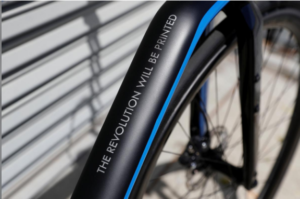 AREVO has always been a company that thinks outside the box. The startup, based in Silicon Valley, is known for its six-axis robotic additive manufacturing platform for the creation of composite parts. It’s the first 3D printing system to combine a standard six-axis commercially available robotic system with advanced 3D printing technology, and today AREVO is showing off its capabilities with a 3D printed carbon fiber bicycle. The company is using the bicycle to demonstrate its software and 3D printing technology, and with a new round of funding and a new CEO, AREVO is riding high.
AREVO has always been a company that thinks outside the box. The startup, based in Silicon Valley, is known for its six-axis robotic additive manufacturing platform for the creation of composite parts. It’s the first 3D printing system to combine a standard six-axis commercially available robotic system with advanced 3D printing technology, and today AREVO is showing off its capabilities with a 3D printed carbon fiber bicycle. The company is using the bicycle to demonstrate its software and 3D printing technology, and with a new round of funding and a new CEO, AREVO is riding high.
New CEO Jim Miller formerly worked at Google and Amazon, overseeing the latter’s expansion from a website that sells books to a full-scale fulfillment platform as Vice President of Supply Chain. As Vice President of Worldwide Operations at Google, he led the team that built the company’s main infrastructure, including the search engine, YouTube, Gmail, advertising and cloud businesses.

(L-R) AREVO CEO Jim Miller, CTO Wiener Mondesir, Chairman and Co-Founder Hemant Bheda [Image: REUTERS/Stephen Lam]
“AREVO is at an exciting inflection point in its business right now,” said Miller. “We have the technology, team and tools to commercialize our software and fabrication process to build high strength parts that the manufacturing industry hasn’t been able to conceive and construct before.”
AREVO’s technology combines 3D printing, a robotic arm and a spinning plate, along with advanced software, that can create composite parts quickly and at low cost. Company founder Hemant Bheda said that the technology improves upon traditional 3D printing methods.
“When we looked at the current 3D printing that has been applied for prototyping, the layers are deposited in a planar fashion on an X-Y plane,” Bheda said. “Our observation was that this gives rise to weakness in the Z direction, which needed to be addressed.”
- [Image: AREVO]
- [Image: REUTERS/Stephen Lam]
A carbon fiber bicycle was the perfect way to demonstrate the potential of the system. Typically, a carbon fiber bike is expensive and labor-heavy; workers lay individual layers of resin-impregnated carbon fiber around the frame by hand. The frame then gets baked in an oven to melt the resin and bind the layers together. AREVO’s robot arm-mounted deposition head lays down strands of carbon fiber and melts a thermoplastic material to bind the strands all in one step.
AREVO’s process requires almost no human labor, allowing the company to 3D print the bikes for about $300.
“We’re right in line with what it costs to build a bicycle frame in Asia,” Miller said. “Because the labor costs are so much lower, we can re-shore the manufacturing of composites.”
Not only is AREVO’s bike, which was created in collaboration with Studio West, cheaper to make than traditional carbon fiber bikes, it’s stronger, too, thanks to a simplified design that removes a seat stay between the seat and back wheel. The process is also much faster, allowing the bike to be created in about 18 days as opposed to 18 months, according to Bheda. In addition, it allows for the easy creation of custom-sized bicycles.
AREVO is in talks with several bicycle companies, but has also received interest from consumer products, aerospace, oil and gas, and consumer electronics companies. AREVO’s technology could easily be scaled up to 3D print aerospace parts; the print head could run along rails to print larger parts and avoid the need for huge ovens to bake the parts in.
“We can print as big as you want – the fuselage of an aircraft, the wing of an aircraft,” Miller said.
“We want to prove that we can deliver on the promise we’re making, that we can make parts at scale,” said Bheda. “For us to successfully address a trillion-dollar market with this technology, we have to prove that we can make 10,000 or 20,000 parts with this technology.”
Discuss this and other 3D printing topics at 3DPrintBoard.com or share your thoughts below.
[Sources: Globe Newswire, Robotics Business Review, Reuters / Video: Robotics Business Review]
Subscribe to Our Email Newsletter
Stay up-to-date on all the latest news from the 3D printing industry and receive information and offers from third party vendors.
You May Also Like
3D Printing Unpeeled: New Arkema Material for HP, Saddle and Macro MEMS
A new Arkema material for MJF is said to reduce costs per part by up to 25% and have an 85% reusability ratio. HP 3D HR PA 12 S has been...
3D Printing News Briefs, January 20, 2024: FDM, LPBF, Underwater 3D Printer, Racing, & More
We’re starting off with a process certification in today’s 3D Printing News Briefs, and then moving on to research about solute trapping, laser powder bed fusion, and then moving on...
3D Printing Webinar and Event Roundup: December 3, 2023
We’ve got plenty of events and webinars coming up for you this week! Quickparts is having a Manufacturing Roadshow, America Makes is holding a Member Town Hall, Stratafest makes two...
Intuitive Machines Debuts $40M Hub for Lunar Ambitions and 3D Printing Tech
Best known for its pioneering work in lunar exploration and its development of the Nova-C lunar lander, Intuitive Machines (Nasdaq: LUNR) has marked yet another significant milestone. The leading space...


































